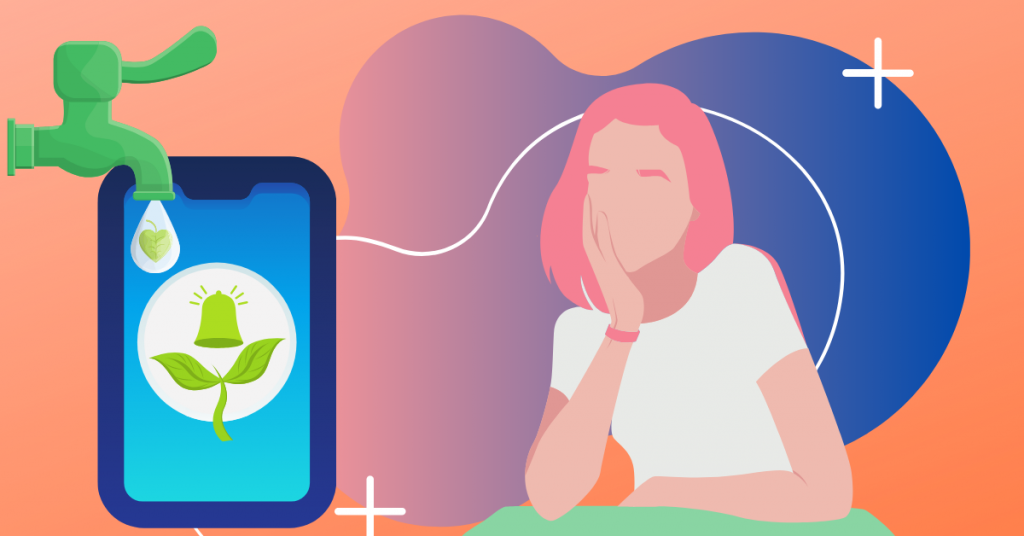What is a drip campaign? Drip marketing campaigns are a series of messages that educate people discovering a brand for the first time or nurturing them along the customer lifecycle.
Drip campaigns are traditionally executed via email or direct mail, but there’s been an exciting new development in the world of marketing automation —
Modern marketers have found 2-way messaging platforms like SMS and Facebook Messenger are more personal, engaging, interactive, and develop more loyal customers.
Today I’m going to show you how to fully automate a prospect’s or customer’s awareness and consideration journey through drip marketing, with a deep dive into the new best practices for chat marketing drip campaigns.
We include step-by-step guide to setting up SMS drip campaigns and Facebook Messenger drip campaigns for welcoming, onboarding, and more, to copy for your own campaigns.
Jump to each section using the links below or read ahead for your total guide from what is a drip campaign to creating uber-engaging chat drip campaigns.
- What is a drip campaign?
- Why are drip campaigns so useful?
- 3 important drip campaign use cases
- The new way to drip: Drip marketing in text and chat apps
- How to make a chat drip campaign in 8 steps
- How to optimize chat drip campaign for top-tier engagement
- Drip marketing campaign FAQs
Join Today’s Webinar with Larry Kim!
Or Register for the Free Replay
Learn all about NEW 100% Meta-Approved Automation Tools from Customers.ai with a spotlight on features to 10X Instagram & Facebook Engagement and turn social media into a revenue driver for your business.

What is a drip campaign?
Drip marketing definition: A drip campaign is a marketing communications strategy that consists of pre-produced content, delivered to a subscribed audience over a pre-determined period of time.
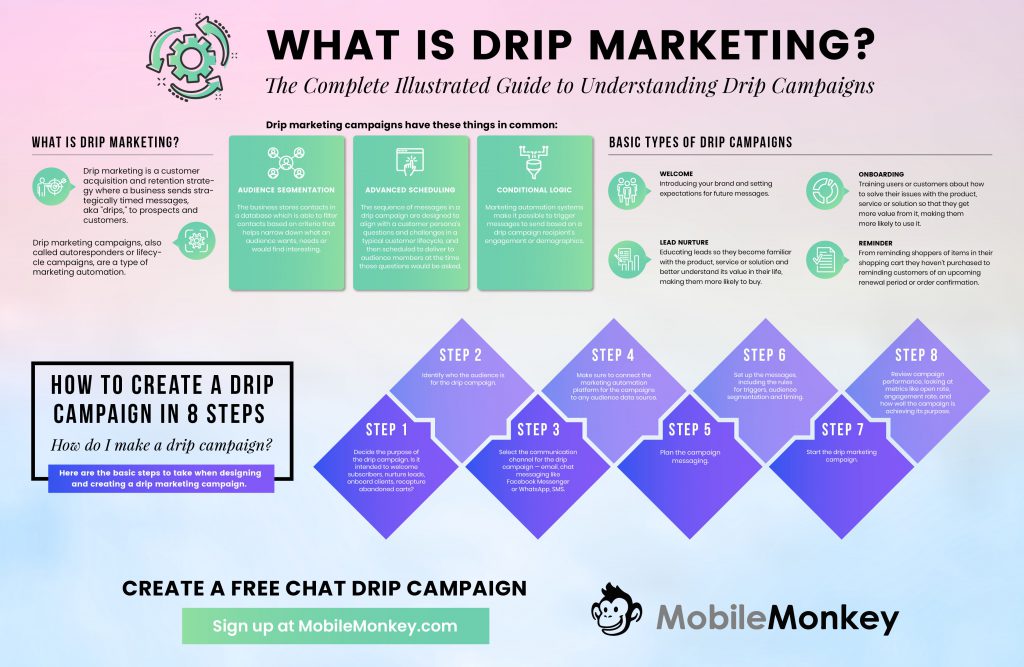
Traditionally drip campaigns are delivered through the form of direct mail.
Over the past 20 years, due to its low cost base and ease of delivery, email has become the preferred method to deliver drip campaigns.
More recently, due to the rapid growth and proliferation of communication apps such as Facebook Messenger and WhatsApp, drip campaigns have evolved to messaging app chatbots that initiate real-time, one-on-one customer communication.
Whether you’re planning a drip campaign for email or chat, the general planning steps are the same.
Here is how to run a drip campaign in 8 steps on any channel:
- Step 1: Decide the purpose of the drip campaign. Is it intended to welcome subscribers, nurture leads, onboard clients, recapture abandoned carts?
- Step 2: Identify who the audience is for the drip campaign.
- Step 3: Select the communication channel for the drip campaign — email, chat messaging like Facebook Messenger or WhatsApp, SMS.
- Step 4: Make sure to connect the marketing automation platform for the campaigns to any audience data source.
- Step 5: Plan the campaign messaging.
- Step 6: Set up the messages, including the rules for triggers, audience segmentation and timing.
- Step 7: Start the drip marketing campaign.
- Step 8: Review campaign performance, looking at metrics like open rate, engagement rate, and how well the campaign is achieving its purpose.
Email drip marketing and chat marketing drip campaigns always do these things:
- Audience segmentation: The business stores contacts in a database which is able to filter contacts based on criteria that helps narrow down what an audience wants, needs or would find interesting.
- Advanced scheduling: The sequence of messages in a drip campaign are designed to align with a customer persona’s questions and challenges in a typical customer lifecycle, and then scheduled to deliver to audience members at the time those questions would be asked.
- Conditional logic: Marketing automation systems make it possible to trigger messages to send based on a drip campaign recipient’s engagement or demographics.
Why are drip campaigns so useful?
Drip campaigns give marketers and businesses the ability to build a relationship with leads and customers.
This is really important in marketing when you’re first interacting with a new prospect or a new lead because that means that they’re in a “consideration” phase.
They’re thinking about you, they’re thinking about your industry and it gives you a really great opportunity to capitalize on that timing and make sure that your brand is top of mind for the next few hours, days or weeks – however long your consideration process tends to be for your industry.
It’s also important to educate your audience so you can build trust. if you tell your customers things they don’t already know, you’re demonstrating that you are an expert in the field that you’re selling in.
It also means that you can use these conversations to learn more about what your consumers actually want. Ask questions to give you the data for how to segment an audience. That’s an especially useful aspect of messaging drip campaigns as opposed to email, which can be less interactive (check out our email capture chatbot too).
Building strong relationships with audiences
You can prompt your messaging contacts to share things with you that you don’t already know. This is also a great way to build a relationship, a two way relationship between you, your brand, and your leads or customers.
People are naturally more likely to do business with someone they’re familiar with. And brands who are able to add value and show expertise seize on this great opportunity to develop how they’re perceived by leads and customers.
Drip campaigns are a really important aspect of building customer relationships during the initial few hours or days since the initial connection was made.
3 Important Drip Campaign Use Cases
1. Lead nurture drip campaign
A lead nurture campaign gently encourages your subscribed audience to trust your brand more through the sharing of content that resonates with them.
For example, when we published the first episode of Chat Marketing Train, we gently nurtured our audience by making them aware that the new content had been published using the Customers.ai chatbot.
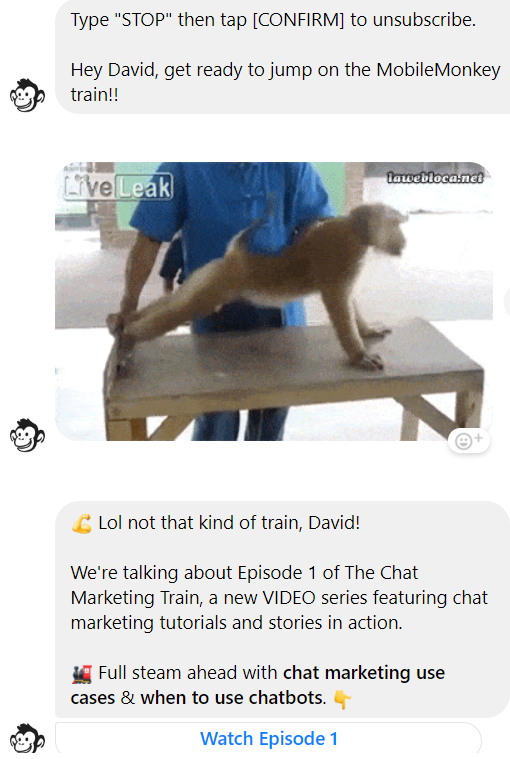
According to Hubspot:
- Nurtured leads convert 20% more that leads that aren’t nurtured.
- Prospects often require at least 10 touches before a sale can be made.
- The odds of a lead entering the sales process are 21x greater when contacted within 5 minutes.
2. Subscription drip campaign
A subscription-based drip campaign can be even more effective. This is because your subscribers have asked to receive very specific content from you.
For instance, Customers.ai hosts quarterly virtual marketing summits.
This means that everyone who subscribes to watch the virtual summit has stuck their hand up to receive content about the virtual summit.
We’d be failing in our duty if we didn’t provide a drip campaign with content from the virtual summit.
3. Onboarding drip campaign
Thirdly, when someone becomes a customer, don’t suddenly forget about delivering relevant timely content.
According to podcasting guru Mark Asquith, one of the guests who contributed to my recent book, Marketing Now, focusing on your on-boarding has a dramatic effect on your business success.

Mark said:
“If you can market and you can sell and you can create the most wonderful experience to the point that someone buys – and after that, you drop the ball, your churn’s going to go up. Focus an incredible amount on your on-boarding – the welcome sequences, the personal touches. This is something that you should integrate into the first three months of a customer using your product or service.”
An on-boarding drip campaign is one of the ways that you can deliver this wonderful initial experience that we all wish to deliver.
4. Reminder drip campaign
One more to mention in this list of basic types of drip campaigns is the reminder drip series.
From reminding shoppers of items in their shopping cart they haven’t purchased to reminding customers of an upcoming renewal period or order confirmation, a drip marketing campaign can be triggered to assist shoppers or prospects in making their next purchase.
The new way to drip: Drip marketing in SMS and chat apps
Consider using chat marketing to deliver your drip campaign instead of email.
Especially if you’re thinking about your communication with a new lead over the initial 24-hour period.
If you receive a large number of emails in one day from a company, it’s natural to perceive that as spam.
However, when you chat with one of your Facebook Messenger contacts, creating a drip campaign on Instagram, or via SMS, the same quantity of messages isn’t so negatively perceived.
This is partly because the messages tend to be shorter.
When communicating via chat, limit your messages to 200 characters, maybe a sentence and a question.
An audience will be a lot less sensitive to receiving several of those a day as opposed to receiving several emails.
To avoid being perceived as spammy, set expectations properly and enable users to easily opt-out.
Help them understand what the audience is signing up for. When context and expectation is established, messaging frequency can be higher than email.
SMS and chat drips are a 2-way conversation
Unlike drip marketing in email or mail, SMS drip campaigns and Facebook Messenger drip campaigns are interactive and reactive.
Chat is not a one-direction channel; there is learning happening in both directions.
What’s beautiful about these chat flows is that you’re able to make them inside a drip campaign from which you can route them one way for a positive answer, and one way for a more negative answer.
Either way, you’re going to learn a lot about how your customers perceive your brand.
Then you can feed those learning back, not only into your drip campaign, but also into your business as a whole.
SMS and chat drips create smart follow-up
You can also implement this as a way to positively stoke your app ratings. i.e. if a customer responds to your initial question in a negative manner, using this as a learning opportunity.
However, if a customer responds by giving you a positive rating, it gives you an opportunity to ask a follow-up question that requests them to leave an app rating and review.
How to make a chat drip campaign in 8 steps
Let’s now walk you through an example of how to create a drip campaign in 8 simple steps.
As you can imagine, users who tend to first interact with this event planner are in the process of exploring different options to plan a wedding, party or function.
This is important to keep in mind when we’re building our drip campaign case study. Check out more chatbot case studies here.
To start off, inside Customers.ai, we navigate to “marketing automation” and then “drip campaigns”.
Now we’re in the right section inside Customers.ai, let’s create a new drip campaign.
Step 1: Give the drip campaign a name.
We’ll give our drip campaign a name. This particular campaign is going to be used for onboarding.

Note that you can use drips to do a lot of different things, but it’s a great way to start onboarding and nurturing.
Step 2: Choose the type of campaign.
If somebody’s new to our brand, these are the initial messages they’re going to receive. We’re going to set up this campaign for Facebook Messenger.
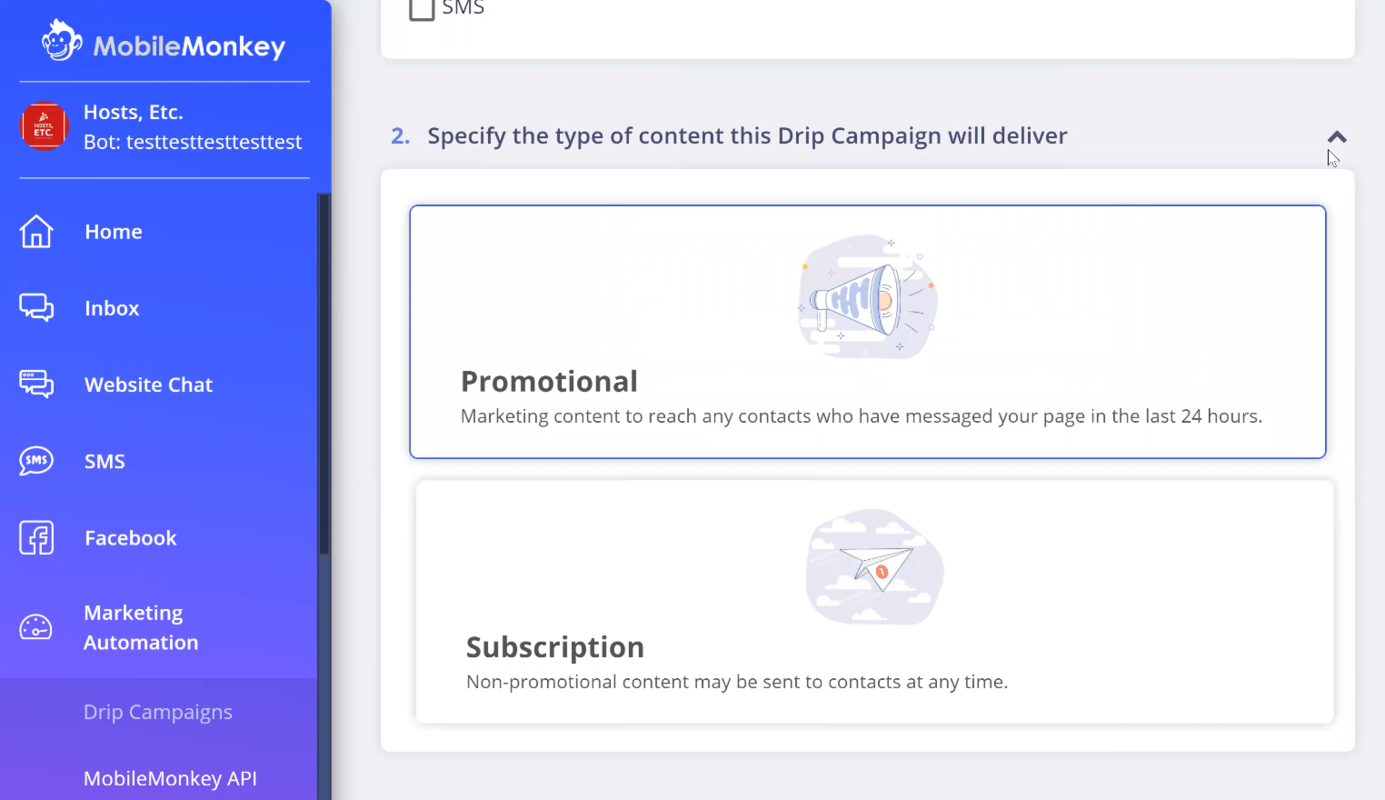
As we’re setting it up, we select “promotional” even though it’s not going to be used for hard selling.
Step 3: Choose the audiences that you wish to send the drip campaign.
In this example I’m going to choose the audience called “All Contacts”.
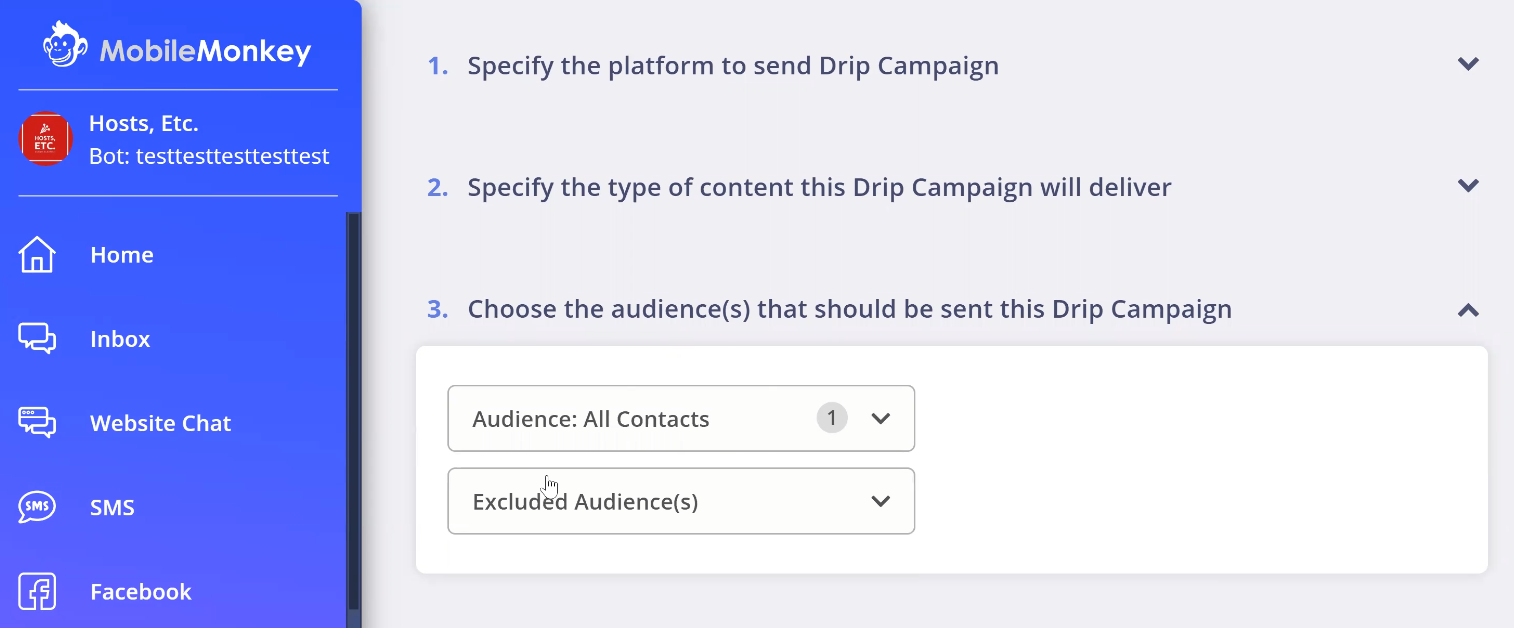
This means whenever contact enters this audience (this particular list), they’ll be sent the first message of this drip campaign.
Step 4: Select the drip schedule.
There is a neat feature that allows you to choose a schedule during which your drip campaign messages will be sent.
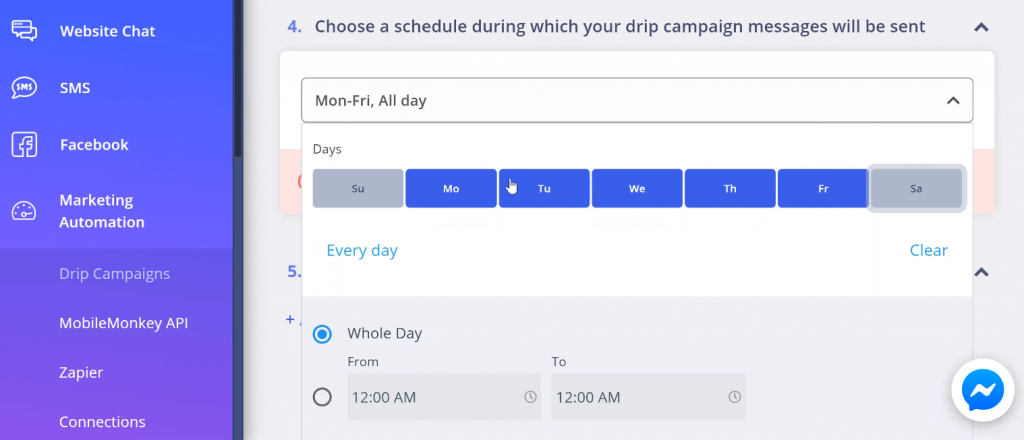
If you want to prevent your messages from being sent on weekends or during someone’s night-time, you can do it using this little tool in this section of Customers.ai. For this example I’ll just make sure that these messages are only sent Monday to Friday.
Step 5: Write the drip messages.
Next, what you want to do is to decide on your message, i.e. the core crux of the conversation.
Step 6: Select the time for messages to be sent.
The first thing you do whenever you create a new one conversation is to choose the time that you wish your message to be sent – i.e. the period after the last message received, or after the contact joins the audience.

In this case we’re setting it up so they receive the first message as soon as they join the audience, but we can delay this for any time period we desire.
Step 7: Add conversation widgets.
Let’s add a conversation widget to the campaign. Within this text, it’s good practice to try to make sure that the user or the contact knows that they’re able to unsubscribe very easily, directly from a campaign message.
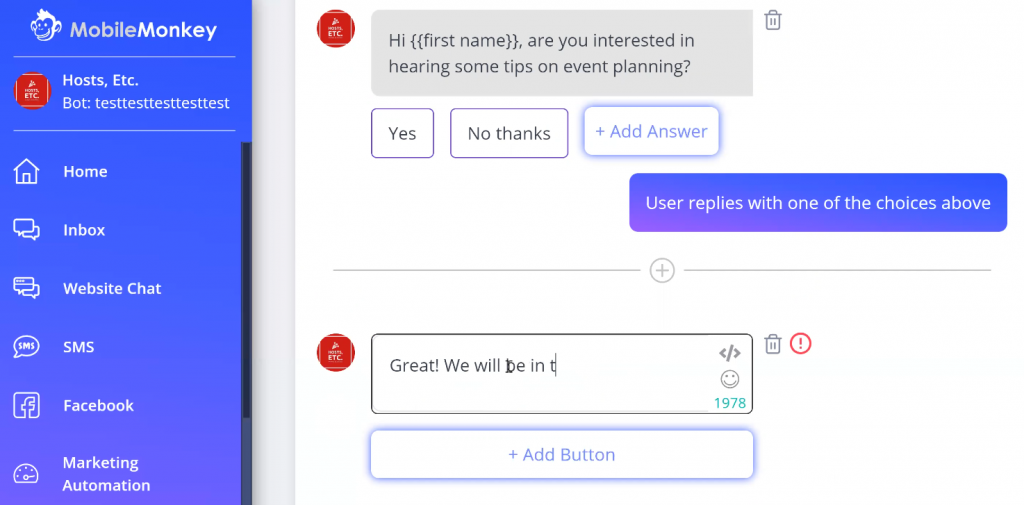
To ensure that your users know this, write “Just reply type ‘stop’ at any time to unsubscribe” above each message that you send.
After that you may want to ask your message recipients a question. In my example it’s going to be, “Hi first name, are you interested in hearing some tips on event planning?”
Try providing your user with a couple of options here. In our example we’ll offer “Yes” and “No thanks”. Great. Our answer to a positive response will be “Great, we will be in touch with the tips.”
Step 8: Ensure that you’ve catered for all the conversation scenarios.
In reality we’d also like to establish a set of responses for a negative response, but as this it just an example, let’s just focus on dealing with the “Yes” response.
Our next job is to decide on a drip to send whenever a user provides us with a positive response.
We can then set another time period to lapse – say an hour but it could be more and could be less – and then we’ll send the recipient our first tip.
For this example we’ll say “tip number one is to always over communicate with everyone involved in planning your event”. It’s not a particularly helpful tip, but you get the idea!
How to optimize chat drip campaigns for top-tier engagement
Drip marketing campaigns sent via messaging apps have much higher engagement, interaction and rich media content than drip campaigns sent via email or direct mail.
These are the pro tips for amping up the engagement factor, delighting leads, and as a result, increasing response rates.
Drip marketing engagement tip #1: Make chat messaging content brief, visual and interactive
Facebook Messenger and SMS are unique in that they are fun and interactive. That’s something to take advantage of in chat drip campaigns.
When you’re sending out drip messages in chat, make them engaging by adding a GIF.
This is really easy to do through the Customers.ai GIF widget.
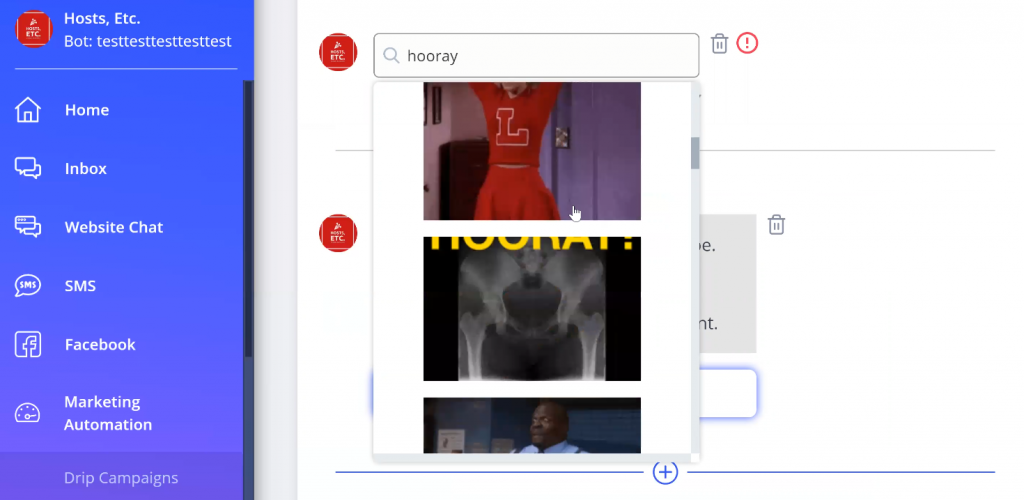
Then, you can carry on sending out your tips. Be a little bit careful about the quantity you send.
A maximum of 3 in the first day is generally OK.
After that you may try a soft-sell to encourage the user to get back to you or to check out your products or services.
Drip marketing engagement tip #2: Be educational before you try sell.
Drip campaigns work by creating a relationship. Say you go to a networking party. Do you go right into selling them your products or services? You probably get to know them and tell them a little about you first.
Chat drip campaigns are like that, a chance to get to know each other.
Start with education and see if it makes sense to continue the conversation.
Say it’s three hours since a recent educational tip was sent.
We could now say something like “How about we get on the phone to discuss the event you’re planning? and you could leave “Sounds good.” or, “I’m not ready yet.” as response options.
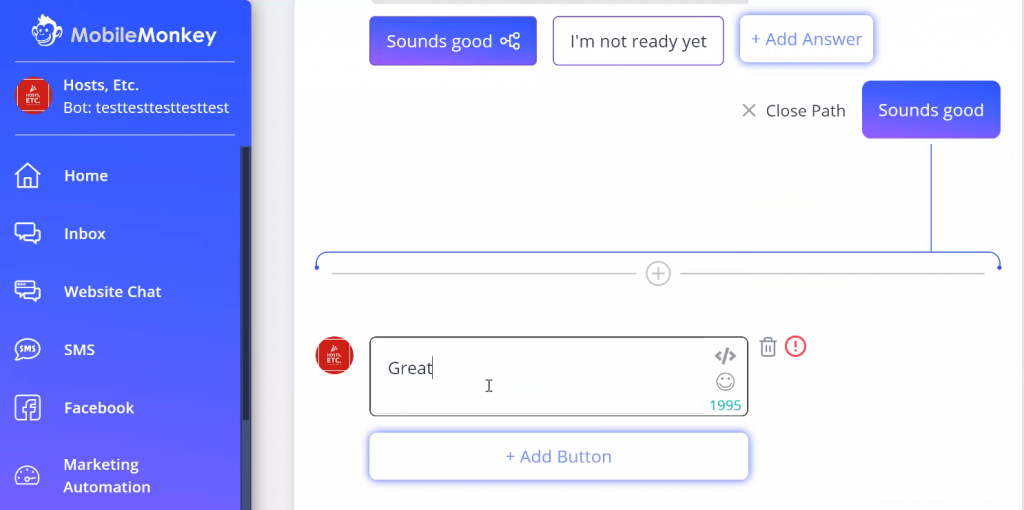
If someone clicks on “sounds good” you’d want to add a notification widget to send somebody an email notification who might handle this sale to get in touch with the lead and to do so quickly when the prospect is ‘hot’ (check out our plans for teams here).
Drip marketing engagement tip #3: Gather as much feedback as you can from customer conversations.
We recommend ending a welcome drip sequence or nurture drip sequence with a survey.
This gets back to the fact that chat drip marketing gives businesses a channel for real-time feedback from prospects or customers.
By creating a survey within your drip campaign you will learn more about who the audience member is and what you can offer them.
At the end of your chat drip campaign build, it’s a good point to start to think about incorporating this, maybe saying something like “Mind letting us know how your experience was with Hosts, Etc.?”

It’s important to do things such as adding in a couple of smiley faces too – remember that people communicate on chat quite differently to how they might write an email.
If we receive a positive response we may ask the user to leave a review on Facebook, Yelp or whatever platform is important to our business.
Drip Marketing Campaign FAQs
How often should drip marketing messages be sent?
Based on data we’ve seen, you don’t want to keep on sending as many messages as you did in the beginning.
After the first 24 hours your frequency of message sending should more closely reflect what you’re currently doing with email.
However, remember that chat drip campaigns are two-way and you should expect to get responses from a significant percentage of people who you reach out to.
Once people respond to you, they’re more amenable to receiving more messages from you over a short period.
Keep in mind that you should always give the message recipient an easy option opt-out of continuing the conversation.
What’s an ideal call-to-action for a drip campaign?
Is it better to encourage your audience to click on a link or to continue the conversation within the messaging platform?
Both of these are effective CTAs, especially in the beginning of a relationship. If you have great content that you want to send them to it’s best to just serve that up right away.
Later down the road when you’re messaging them with a survey, you might want to have that be a bit of a back and forth.
If you’re asking your audience questions that expect to have meaningful answers, then it’s great to do it in chat.
But if you’re just trying to get them to interact for the sake of interacting, consider skipping this step and sending them straight to a URL.
Is it important for every business actively using chat to utilize drip campaigns?
Yes. There isn’t a reason why drip campaigns wouldn’t be universally inapplicable. Drip campaigns are so versatile. You can use them to get feedback from customers, to educate customers. You can also use them to nurture towards a soft sell.
There are so many different great use cases for drip campaigns. Even though they’re called drip campaigns, they can be used for a bunch of different types of sort of repeated message flows.
It is recommended that one of the first things you do when you’re setting your Customers.ai account is to dive into drip campaigns.
Why are audience surveys great and how can you incorporate them into drip campaigns?
Surveys are great because as businesses we should always be taking opportunities to learn more from our customers. The best way to get a competitive edge over similar businesses is by learning more than they do and knowing more about what the target market really wants.
A great thing about chat drip campaigns, especially compared to email drip campaigns, is that you’re able to have a two-way interaction with your message recipients. A survey is a great way to do this.
Start by just asking your message recipients a simple question such as “How would you rate us on a scale of one to five?” Then make it easy for them to respond.
If they respond by rating you as a one, two or three, you could ask “What could we be doing better?” However, if they respond by saying four or five, you have an opportunity to learn about what you’re doing great!
What’s a more unusual example of a really effective use of drip campaigns?
You can also use drip campaigns to nudge prospects to finish their lead generation flow. i.e. when someone starts replying to your questions but if they don’t actually finish that whole flow, consider adding them to an “Incompletions” audience
Then, when they’re in that audience you can send them reminders to complete what they haven’t completed earlier. This is an interesting way to use a drip campaign as it doesn’t have that ‘nurture’ intent.
How do you decide on the content to include in your drip campaigns?
As far as content and tone of voice goes, experimentation is a good baseline. Make sure that you’re continually testing what works and what doesn’t. Customers.ai provides bot analytics so you can see which messages have the highest read and response rates.
You’ll also know which of your messages are performing more poorly. You can then take this as an opportunity to adjust your content. Remember, your messaging tone can be a little bit more informal than your email tone.
If it really feels like chat, your audience will be more inclined to respond. And be sure to use lots of media – a lot of GIFS and images that make everything feel a little more light-hearted, which always tends to be more effective.
How do you test a drip campaign sequence?
It’s always important to test new conversation sequences, just to make sure that they’re appearing as intended. Let’s preview what we’ve created inside Facebook Messenger.
It’s just so super easy to build a drip campaign inside Customers.ai. It only took me a couple of minutes. You can make these drips as complex or as simple as you want.
What updates are coming to Customers.ai drip campaigns in the future?
Those eagle-eyed of you may have seen in our demo that we had a checkbox for using drip campaigns on SMS. That’s something we’re really excited to launch to everyone (at least in the US and Canada) in the coming weeks.
We’re also thinking about how we can use drip campaign and chat blaster to help our customers who are web chat focused. We know that some people are less excited about using the Facebook parts of the tool, they want to deal more with web chat.
We appreciate that this is exciting as it lets users keep in touch with people who have contacted them on the web chat.
We’re also considering implementing browser notifications that might help to re-engage folks who have left the chat applet.
Customers.ai is a cross-platform marketing solution for SMS, web chat and Facebook Messenger.
We hope that you enjoyed this episode of the Chat Marketing Train.
Are you currently doing chat drip marketing? Let us know how it’s going and any questions you have in the comments.
What is a Drip Campaign: Important Next Steps
FAQ: What is a Drip Campaign?
Q: What is a drip campaign?
A drip campaign is a marketing strategy that involves sending a series of pre-scheduled and automated messages or content to potential customers or subscribers over a specific period. The messages are typically personalized and designed to nurture leads, build relationships, and guide customers through the sales funnel.
Q: How does a drip campaign work?
In a drip campaign, a sequence of messages, such as emails or SMS, is sent to recipients at predetermined intervals or based on specific triggers. These triggers can be actions taken by the recipient, such as subscribing to a newsletter or making a purchase. The content of each message is carefully crafted to engage the recipient and provide relevant information or offers, helping to move them closer to a desired action or conversion.
Q: What are the benefits of using a drip campaign?
Drip campaigns offer several benefits for businesses, including automated and personalized communication with leads and customers, improved lead nurturing and customer engagement, increased conversion rates and sales, time and resource savings through automation, and the ability to deliver targeted content based on recipient behavior or preferences.
Q: What types of businesses can benefit from drip campaigns?
Drip campaigns can benefit various types of businesses, including e-commerce stores, software-as-a-service (SaaS) companies, professional service providers (consultants, agencies, etc.), non-profit organizations, and membership-based businesses. Essentially, any business that wants to engage with their audience, nurture leads, and guide customers through a conversion process can benefit from implementing drip campaigns.
